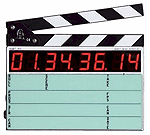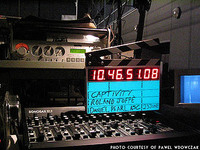 Why use 30 fps Time Code when shooting at 24 fps film? 30 fps Time Code is used when transferring film to 29.97 fps video for video/workstation editing or when transferring to mag film. The following chart shows the frames that are coincident between 30 fps and 24 fps.
Why use 30 fps Time Code when shooting at 24 fps film? 30 fps Time Code is used when transferring film to 29.97 fps video for video/workstation editing or when transferring to mag film. The following chart shows the frames that are coincident between 30 fps and 24 fps.
|
24fps
|
30fps
|
Real Time | |
| Frame # |
0
|
0
|
Start of the Second |
| Frame # |
4
|
5
|
166.6667 mS |
| Frame # |
8
|
10
|
333.3333 mS |
| Frame # |
12
|
15
|
500 ms (Half a Second) |
| Frame # |
16
|
20
|
666.6667 ms |
| Frame # |
20
|
25
|
833.3333 ms |
As seen in the chart above, every fourth frame at 24 fps matches every fifth frame at 30 fps. The film transfers at a rate of 23.976 fps when converted to video at 29.97 fps during the 3-2 pulldown. At the same time the audio is also slowed down from 30 fps to 29.970 fps. This results in an exact match in the video transfer. Recording 30 fps time code at 48 KHz means that the transfer house has to sample your tape at 47.952 KHz (using special decks) to achieve the .1% pulldown necessary for the 3-2 pulldown. If the recorder supports the 48.048 KHz sampling rate then the tape can be played back at 48KHz, which produces the same .1% pulldown using the standard available decks.
The audio can then stay in the digital domain. NTSC video frames are composed of two interlaced fields, each containing half the picture information. One field contains all the odd scan lines, the other all the even scan lines. When 24 frame film is transferred to NTSC, the first film image is placed in three successive video fields and the second frame image is placed in the next two successive video fields. This process is repeated until the end of the film. Artifacts of this process can be seen if you play the videotape in very slow motion. There are many good resources available for more information on the 3-2 pulldown process.
How does this relate to 23.976 fps and HD?
High Definition Cameras are in fact capable of running 24 fps progressive scan. This is different than NTSC, which is 29.970 interlaced. If you use 24P (P = Progressive), it must be down converted to 29.97 fps NTSC for video assist or editing on an Avid. Also, when running 24P the audio TC must run at 30 fps. Currently the down conversion from 24P is not practical. A solution is to run the HD camera at 23.976. The High Def conversion to NTSC video can then use the available standards converters. The following chart shows the frames that are coincident between 29.970 and 23.976.
|
23.976fps
|
29.970fps
|
Real Time | |
| Frame # |
0
|
0
|
Start of the Second |
| Frame # |
4
|
5
|
166.8333 mS |
| Frame # |
8
|
10
|
333.6667 mS |
| Frame # |
12
|
15
|
500.5 ms (Half a Second) |
| Frame # |
16
|
20
|
667.3333 ms |
| Frame # |
20
|
25
|
834.1667 ms |
Again, every fourth frame at 23.976 fps matches every fifth frame at 29.970 fps. What does this mean to the audio Time Code? Just run it at 29.97 fps! The same sync relation from the 3-2 pull down chart holds true. The difference being that there is not a speed change on the audio or video and the sampling rate can stay at 48KHz.
What do I do on the set?
 Until modern audio recorders support the 23.976 frame rate all we can do is "Cross Jam." What is really important here is that the jam sync occurs on the "00" frame. The zero frame is the start of the second (real time or not). All Denecke products have always done this so there is no problem there. If your recorder jams on the zero frame, i.e. Nagra IV-STC, then you can cross jam directly without having to use one of our boxes. HHB and PD-4 owners can cross jam using the Denecke Syncbox or GR-1. Simply feed the 23.976 TC out of the HD Camera and into the Syncbox or GR-1 set to 29.97 Non Drop and jam sync them as usual. Then simply take the 29.97 code over to your recorder (set to 29.97 Non Drop) and jam sync or external feed the recorder with the Syncbox or GR-1.
Until modern audio recorders support the 23.976 frame rate all we can do is "Cross Jam." What is really important here is that the jam sync occurs on the "00" frame. The zero frame is the start of the second (real time or not). All Denecke products have always done this so there is no problem there. If your recorder jams on the zero frame, i.e. Nagra IV-STC, then you can cross jam directly without having to use one of our boxes. HHB and PD-4 owners can cross jam using the Denecke Syncbox or GR-1. Simply feed the 23.976 TC out of the HD Camera and into the Syncbox or GR-1 set to 29.97 Non Drop and jam sync them as usual. Then simply take the 29.97 code over to your recorder (set to 29.97 Non Drop) and jam sync or external feed the recorder with the Syncbox or GR-1.
The Time Code Slate is handled in the same fashion. Set it to 29.97 and jam it either from the camera or the cross-jammed Syncbox or GR-1. Treat this as a 29.97 video shoot. Keep in mind that this procedure only works for Free Run / Time of Day shoots. Be aware that if the camera is powered down for a battery change, etc. then the camera code will not be concurrent when powered back up. In this case you will need to re-jam everything. As always, communication is very important between the camera and sound departments!
An alternate method and the simplest way for Free Run shoots is to feed external code to the HD camera. This is useful in multi-camera shoots. Jam sync a Syncbox set at 23.976 to your recorder set at 29.97 ND. Attach the Syncbox to the camera and feed it the Syncbox code. A software upgrade is available for all the Denecke Products (TCXO preferred for high stability) to enable the generation of 23.976 fps. The catch is that HD cameras want to see Tri-Level Sync + Time Code for absolute frame accuracy. When feeding external time code only, without Tri-Level sync reference, the camera can be in sync or one frame off but not more than that. This can easily be corrected in post, especially when using a Time Code Slate. When external sync is fed to HD cameras, this sync becomes the master reference for the camera and must be extremely stable.
Another option is to ignore the 23.976 on the camera completely. Run your audio recorder with Time of Day (29.97fps) and jam sync your slate as usual. You can take the output of a Syncbox that has been jammed to your recorder (29.97fps) and feed it into track 2 of the HD camera that can be used in editorial. The audio will stay at 29.970 fps when it is transferred. Ed Novick used this method on the Spider Man movie with no problems. Also, you don't have to worry about the camera being powered down. Just make sure to communicate with post so they don't get mixed up with the time code on the HD camera audio track!
Record/Run time code is a bit more complicated. The 23.976 TC can be sent via RF or hard wired to the Syncbox or GR-1 (set to 29.97ND). It is necessary to re-jam at the start of each take since the time code clock is stopped when the camera isn't running film. The re-jam process is automatic with a GR-1 in Jam Continuous mode (JC). The GR-1 locks on to the next valid (00) frame anytime there is a break in the time code clock (camera stopped).
What is the Evertz After Burner?
The Evertz After Burner converts 23.976 fps video to 29.970 fps NTSC video. The time code clock is also converted from 23.976 fps to 29.970 fps. This is a rackmount unit that requires AC power. There is a 5 frame offset during the conversion to 29.97, but this can be handled in post. The drawback is that you have to be hard wired (at least for the video feed). There should be a corresponding audio delay to compensate for the video delay. Check out the Evertz website at www.evertz.com for more information.
What is Tri-Level sync?
The NTSC video signal consists of a Blanking Pulse (sync pulse + color burst + back porch) followed by the video image data. This signal is repeated every scan line (525 NTSC, 625 PAL) to make up the video frame. High Definition video uses what is called Tri-level sync. This signal consists of a three level sync pulse (0 V Blank, -.3 mV pulse, +.3 mV pulse) followed by the video image data. This signal is repeated every scan line to make up the video frame. HD cameras do not genlock or reference to a NTSC/PAL video sync signal.
 What all of this means.
What all of this means.
Understanding the 3-2 pulldown and how 24 fps and 30 fps relate it is easy to see how 23.976 fps and 29.970 fps relate as well. Don't be confused by these "new" numbers. 23.976 fps is used so that down conversion for contemporary video assist is a simple real time matter. The good news is that there really is nothing new. As always, communication between camera and sound departments is very important! Detailed explanations on the 3-2 pulldown transfer of 24fps film to 29.97fps video are available in the books "Using Time Code In The Reel World III" by Jim Tanenbaum or "Sync Sound With The New Media" by Wolf Seeberg. Wolf's book, "24P for Sound & Video Assist," covers the Sony HDW-F900 HD camera.
By Charles Parra, Denecke Inc.
Courtesy of Denecke, Inc.
Many thanks to Ray Cymoszinski for his invaluable help and guidance.